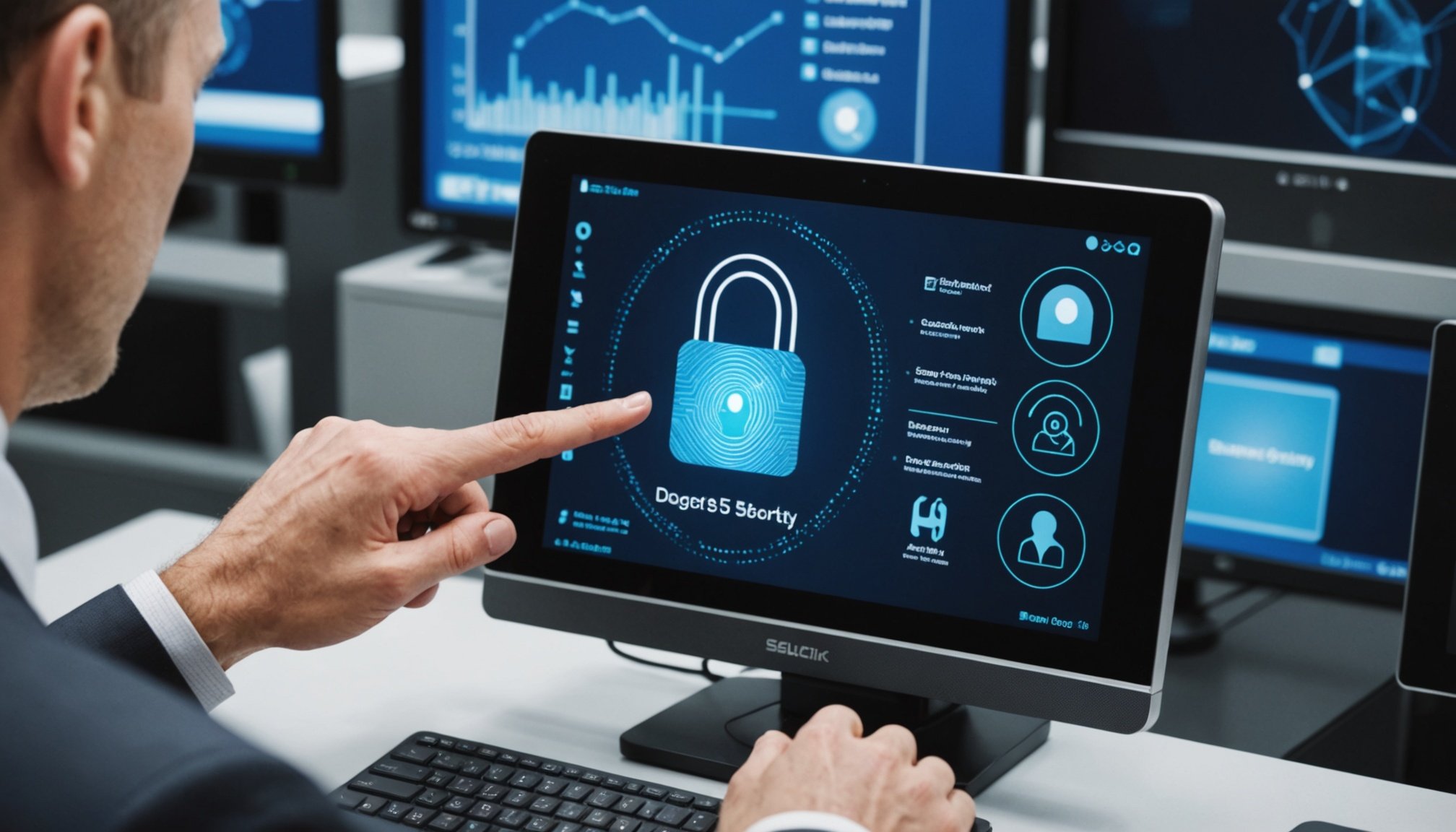Unlocking the Future: Cutting-Edge Biometric Security Solutions for Enhanced Safety in Banking Transactions
In the ever-evolving landscape of banking and financial transactions, security has become a paramount concern. As technology advances, traditional methods of authentication, such as passwords and PINs, are no longer sufficient to protect against increasingly sophisticated threats. This is where biometric security solutions come into play, revolutionizing the way we secure our banking transactions.
The Rise of Biometric Authentication
Biometric authentication, which uses unique physical or behavioral characteristics to verify identity, is rapidly becoming the new standard in security. This method offers a significant enhancement over traditional authentication methods, providing a more secure, convenient, and user-friendly experience.
Topic to read : Transformative fiber optic innovations boosting internet speed and dependability in the uk”s remote areas
Why Biometrics?
Here are some key reasons why biometrics are gaining traction:
- Enhanced Security: Biometric data, such as fingerprints, facial features, and voice patterns, are unique to each individual, making it virtually impossible for unauthorized access.
- Convenience: Biometric authentication eliminates the need to remember complex passwords or carry physical tokens, streamlining the login process.
- User Experience: Biometric systems are generally more intuitive and easier to use, reducing friction in the user experience.
Types of Biometric Authentication
Several types of biometric authentication are being integrated into banking systems, each with its own set of advantages and applications.
In the same genre : Transforming short-haul aviation: breakthrough innovations elevating electric aircraft efficiency
Fingerprint Recognition
Fingerprint recognition is one of the most common forms of biometric authentication. It involves scanning the unique patterns found on an individual’s fingertips to verify their identity.
- Example: The use of fingerprint-enabled credit cards, such as the biometric credit cards mentioned by BforBank, allows users to make contactless payments without entering a PIN, even for transactions above the usual contactless limit[1].
Facial Recognition
Facial recognition technology uses advanced algorithms to map and analyze the unique features of an individual’s face.
- Example: This technology is already being used in various banking apps to authenticate users before allowing access to their accounts. For instance, some banks use facial recognition to secure mobile banking transactions, ensuring that only the account holder can access the account[1].
Voice Recognition
Voice recognition involves analyzing the unique characteristics of an individual’s voice to verify their identity.
- Example: Voice recognition is being used in some banking systems to authenticate users over phone calls or through voice assistants, providing an additional layer of security without the need for passwords or PINs[1].
Behavioral Biometrics
Behavioral biometrics involve analyzing patterns of behavior, such as typing habits or gait, to verify identity.
- Example: Some banking apps use behavioral biometrics to monitor how a user interacts with their device, detecting any anomalies that might indicate unauthorized access[2].
How Biometric Systems Enhance Security
Biometric systems offer several layers of security that traditional methods cannot match.
Data Security
Biometric data is highly secure because it is unique to each individual and cannot be easily replicated or stolen.
- Example: When using biometric credit cards, the fingerprint data is stored locally on the card and is not transmitted to any external servers, ensuring complete security and confidentiality[1].
Identity Verification
Biometric systems provide robust identity verification, reducing the risk of identity theft and fraud.
- Example: ComplyCube’s verification solutions combine document verification with biometric identity verification, ensuring that the person submitting the documents is the legitimate owner. This includes advanced features like presence detection to prevent identity usurpation[2].
Access Control
Biometric systems can be integrated into various access control mechanisms, ensuring that only authorized individuals can access sensitive information or perform transactions.
- Example: Worldline’s Trusted Authentication solution offers multi-factor authentication that can be adapted to different use cases, ensuring secure access to banking services across various devices[4].
Table: Comparison of Biometric Authentication Methods
| Biometric Method | Description | Advantages | Disadvantages |
|---|---|---|---|
| Fingerprint Recognition | Scans unique patterns on fingertips | High security, widespread adoption | Can be affected by skin conditions or damage to fingerprints |
| Facial Recognition | Maps and analyzes facial features | Convenient, non-invasive | Can be affected by lighting conditions or facial changes |
| Voice Recognition | Analyzes unique voice characteristics | Easy to use, especially over phone calls | Can be affected by background noise or voice changes |
| Behavioral Biometrics | Analyzes patterns of behavior | Provides continuous authentication | Can be complex to implement and may raise privacy concerns |
The Future of Biometric Security in Banking
As technology continues to evolve, we can expect even more innovative biometric security solutions to emerge.
Post-Quantum Security
With the advent of quantum computing, traditional cryptographic methods may become vulnerable. Biometric security integrated with post-quantum cryptography will be crucial for maintaining the integrity of banking transactions.
- Example: IDEMIA is working on integrating post-quantum cryptography into their biometric solutions, such as quantum-safe SIM cards and secure transactions using TLS connections resistant to quantum computers[3].
Mobile Banking and Digital Wallets
The rise of mobile banking and digital wallets is driving the adoption of biometric authentication.
- Example: According to BforBank, digital wallets are expected to handle a significant portion of e-commerce transactions by 2029, with biometric authentication playing a key role in securing these transactions[1].
Practical Insights and Actionable Advice
For both users and financial institutions, here are some practical insights and actionable advice:
For Users:
- Be Aware of Privacy: Understand how your biometric data is being used and stored. Ensure that the institutions you deal with have robust privacy policies in place.
- Keep Your Device Secure: Regularly update your device’s software and use secure connections to prevent unauthorized access.
- Use Multi-Factor Authentication: Whenever possible, use multi-factor authentication that includes biometric methods for added security.
For Financial Institutions:
- Invest in Robust Biometric Solutions: Implement biometric authentication methods that are secure, user-friendly, and compliant with regulatory standards.
- Educate Users: Inform users about the benefits and security measures of biometric authentication to build trust.
- Stay Updated with Technology: Continuously update and adapt biometric systems to address emerging threats and technological advancements.
Quotes from Experts
- “The biometric verification is becoming rapidly an essential element of electronic identity verification systems (eIDV). It goes beyond static document verification by integrating advanced technologies like facial recognition,” – ComplyCube[2].
- “We have a lot to do to identify and study all the use cases of post-quantum cryptography. This requires the involvement of the entire security ecosystem, as well as practical implementations in real conditions, in close collaboration with our clients,” – Olivier Nora, Chief Open Innovation at IDEMIA Secure Transactions[3].
Biometric security solutions are revolutionizing the way we secure banking transactions, offering enhanced security, convenience, and user experience. As technology continues to evolve, it is crucial for both users and financial institutions to stay informed and adapt to these advancements. By understanding the benefits and implementing robust biometric security measures, we can ensure a safer and more secure financial future.











